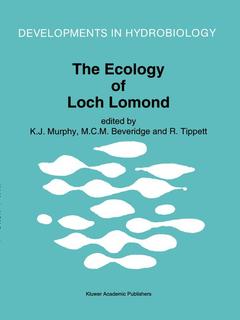The Ecology of Loch Lomond, Softcover reprint of the original 1st ed. 1994 Developments in Hydrobiology Series, Vol. 101
Langue : Anglais
Coordonnateurs : Murphy Kevin J., Beveridge M.C.M, Tippett R.

Loch Lomond has long held a special place in the hearts of all the people of Scotland not only for its historic significance but also for the beauty of its countryside. Less widely known is the ecological importance of the area. It is the largest stretch of freshwater in Britain and the only loch to be crossed by the Highland Boundary Fault, one of the country's most important geological features.
The University of Glasgow has recognized the importance of this loch situated so near the main campus and has operated a field station on its shores since 1948. In the mid-1960s the field station was re-established at Rowardennan as an all-year-round facility with laboratory and living accommodation for resident research workers and visiting field courses. In 1992 a symposium was held to celebrate the 25th anniversary of the opening of the new station and this volume presents the proceedings of that symposium and gives the state of the present knowledge of Loch Lomond. After an introduction to Loch Lomond, the papers are divided into three sections. Section I: The physical and chemical environment of Loch Lomond and its catchment. Section II: The biology and ecology of Loch Lomond and its catchment, and Section III: Issues affecting Loch Lomond and its catchment.
The University of Glasgow has recognized the importance of this loch situated so near the main campus and has operated a field station on its shores since 1948. In the mid-1960s the field station was re-established at Rowardennan as an all-year-round facility with laboratory and living accommodation for resident research workers and visiting field courses. In 1992 a symposium was held to celebrate the 25th anniversary of the opening of the new station and this volume presents the proceedings of that symposium and gives the state of the present knowledge of Loch Lomond. After an introduction to Loch Lomond, the papers are divided into three sections. Section I: The physical and chemical environment of Loch Lomond and its catchment. Section II: The biology and ecology of Loch Lomond and its catchment, and Section III: Issues affecting Loch Lomond and its catchment.
Foreword. Glasgow University Field Station at Rossdhu, Loch Lomond: the first British University Freshwater Field Station; P.S. Maitland, J.D. Hamilton. An introduction to Loch Lomond; R. Tippett. I: The Physical and Chemical Environment of Loch Lomond and its Catchment. August Thienemann and Loch Lomond -- an approach to the design of a system for monitoring the state of north-temperate standing waters; B. Moss, P. Johnes, G. Phillips. Geology of the Loch Lomond catchment; J.G. MacDonald. Aspects of the hydrology and hydrography of Loch Lomond; J.C. Curran, T. Poodle. The physico-chemical limnology of Loch Lomond; G.A. Best, I. Traill. Environmental change and the chemical record in Loch Lomond sediments; J.G. Farmer. Assessment of eutrophication in Loch Lomond by desk analysis; I.D.M. Gunn, A.E. Bailey-Watts, A.A. Lyle. II: The Biology and Ecology of Loch Lomond and its Catchment. Vegetation and land use in the Loch Lomond catchment; G. Dickinson. Freshwater and wetland plant communities of Loch Lomond; K.J. Murphy, K.D. Hudson, J. Mitchell. Zooplankton in Loch Lomond: perspectives, predation and powan; P.P. Pomeroy. The fish community of Loch Lomond, Scotland: its history and rapidly changing status; C.E. Adams. The importance of Loch Lomond National Nature Reserve for Fish; A.A. Lyle, P.S. Maitland. The ecology of lampreys (Petromyzonidae) in the Loch Lomond area; P.S. Maitland, K.H. Morris, K. East. Life histories of the powan, Coregonus lavaretus (L.) (Salmonidae, Coregoninae) of Loch Lomond and Loch Eck; E.A. Brown, D.B.C. Scott. Elevated predation risk associated with inshore migrations of fish in a large lake, Loch Lomond, Scotland; C.E. Adams, D.W. Brown, L. Keay. The ecology of the River Endrick: present status and changes since 1960; C.R. Doughty, P.S. Maitland. The ecology of pelagic communities in Lochan Dubh; R. Tippett. III: Issues affecting Loch Lomond and its Catchment. Report on the Discussion; A.K. Turner.
Date de parution : 10-2012
Ouvrage de 170 p.
19.5x26 cm
Disponible chez l'éditeur (délai d'approvisionnement : 15 jours).
Prix indicatif 105,49 €
Ajouter au panierThème de The Ecology of Loch Lomond :
Mots-clés :
Ecology; Eutrophication; Plankton; environment; hydrology; vegetation; wetland
© 2024 LAVOISIER S.A.S.



